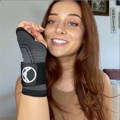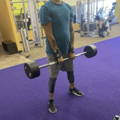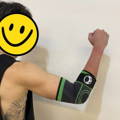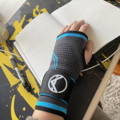
Knee Sleeves for Patellar Tendonitis: Is It Effective?
june 27, 2023 | 4 Mins Read
TABLE OF CONTENTS
1. What Is Patellar Tendonitis ?
2. What Causes Patellar Tendonitis?
3. Symptoms of Patellar Tendonitis
4. Are Knee Sleeves Good For Patellar Tendonitis
5. How Long Should I Wear Knee Brace for Patellar Tendonitis?
6. Alternative Treatments for Patellar Tendonitis
7. How to Choose the Best Knee Sleeves for Patellar Tendonitis?
Patellar tendonitis, also known as jumper’s knee, is a common overuse injury faced by athletes and recreational exercisers alike. For athletes, in particular, it can put an end to their activities and have long-term implications for their health. Many people who suffer from this condition turn to use compression sleeves or wraps for pain relief - but do they actually work?
The primary cause of patellar tendonitis is the overuse of the knee joint, particularly repetitive actions like jumping on hard surfaces.
This condition is often associated with sports-related activities involving frequent leg muscle contraction and the impact of landing on the ground, putting significant strain on the patellar tendon. Over time, this repetitive stress can result in inflammation of the tendon.

Expert tip:
Avoid activities that require frequent tendon flexions such as fast walking, running, deep squats, lunges or sitting in low seats.
The primary symptom of patellar tendonitis is anterior pain, which may be felt in the front of the knee and/or around the kneecap. Other symptoms include:
It’s important to seek medical attention if you experience any of these symptoms as they could be indicative of a more serious condition such as a tear in the tendon.

Knee sleeves have proven to be beneficial for individuals suffering from patellar tendonitis, as well as other related conditions like patella pain, anterior knee pain syndrome, and runner's knee.
The compression therapy offered by knee sleeves promotes better blood flow, reduces swelling, and aids in pain relief and inflammation management.
This can help individuals feel more comfortable while undergoing physical therapy to address the root cause of the problem.
In the case of the runner's knee and patellofemoral pain syndrome, where the kneecap deviates from its normal alignment within the patellar groove, strap-style knee braces can be particularly effective.
These braces feature a strap that applies targeted compression to the patellar tendon, alleviating stress and providing support.
Knee sleeves, often overlooked, are powerful allies when dealing with conditions like patellar tendonitis. Their benefits span from providing targeted compression to enhancing stability, improving circulation, and even preventing re-injury.
However, these are just the tip of the iceberg when it comes to understanding how knee sleeves can revolutionize your journey to recovery.
Discover the full spectrum of benefits by exploring this comprehensive article on the benefits of knee compression sleeves.

Expert tip:
Before wearing knee compression sleeves, we recommend propping your leg up on pillows or a raised surface several times a day or after activities that put stress on the knee.
As a general guideline, if you're engaged in an activity that might strain your knee, like running or jumping, it's beneficial to wear the brace to offer support and reduce the risk of further injury.
Wear it consistently every day for 4 - 6 weeks, during morning and evening physical activity to reap maximum benefit from your knee sleeve.
Post-activity, the knee brace can be worn for several hours. It helps reduce swelling and aids recovery due to the compression it provides. However, it is not typically recommended to wear a knee brace all day and night. Extended use could potentially lead to muscle atrophy, as the muscles become reliant on the brace for support.
In addition to using knee sleeves for patellar tendonitis, there are several other treatment options and complementary strategies that can be incorporated into a holistic approach to managing patellar tendonitis.
Engaging in physical therapy is crucial for addressing patellar tendonitis. A physical therapist can create a customized exercise program that focuses on strengthening the muscles around the knee, improving flexibility, and correcting any biomechanical issues contributing to the condition.
Physical therapy can enhance the effectiveness of knee sleeves by targeting the root cause of patellar tendonitis and promoting proper healing.
The RICE method (Rest, Ice, Compression, Elevation) can be used alongside knee sleeves to alleviate pain and reduce inflammation.
Resting the affected knee, applying ice packs, using compression techniques such as knee sleeves, and elevating the leg can help manage symptoms and support the healing process.
In some cases, over-the-counter nonsteroidal anti-inflammatory drugs (NSAIDs) may be recommended to manage pain and reduce inflammation associated with patellar tendonitis.
Selecting the best knee sleeves for Patellar Tendonitis can be a game-changer in managing pain and enhancing your performance. Here are five critical features to consider while choosing the ideal knee sleeve:
All in all, knee sleeves are an effective non-invasive treatment method to combat patellar tendonitis. With the right care and approach, knee sleeves can provide stability, compression, and support to aching knees and joints.
In your search for the best knee sleeves for patellar tendonitis, thousands have found relief with Koprez Knee Compression Sleeves. These sleeves have gained recognition for their exceptional quality and performance.






References
Author

Claire Evans worked as the content marketing manager at Koprez. Claire combined a background of writing and editing, marketing, and patient education to best serve consumers, fitness enthusiasts, athletes, and anyone who relies on the Koprez brand for helpful information.
Koprez® Featured Products


"I sprain my wrist super often, so I decided to try out this sleeve. This is game-changing! I've been using it for a while now, and my wrists feel amazing. I haven't gotten in any injuries since using it too. It just makes my wrists feel so supported."
Alexis A.


"Use this for my boxing training. It is a very comfortable brace and does not move out of position during skipping ropes and sparring sessions. I use it while running too. Probably the best brace I've purchased throughout the years. It is very flexible. Makes me look like a pro! :)"
Samuel L.


"I've just got back to running after a couple of years of being plagued by injury. These compressions socks are helping give me peace of mind while I build up my distance again. They are the perfect level of compression, super comfy, and very high quality. Feel great while on a run, and looks great in the orange colour I have!"
Dave R.


"I have a weak ankle, and the Koprez ankle sleeve has been a lifesaver. Wear it every day. Super breathable and comfortable. Like wearing a cool sporty looking sock!"
James F.


"This is the best knee sleeve I've ever tried. It's now a must-have for all my exercises. A few years ago, I had an accident that damaged my knees, but with Koprez I can be active again with no knee pains at all. It's been truly amazing!"
Alex M.


"One of the best purchases I've ever made. It fits your legs all the way from top to bottom, great snug fit, gives you support and definitely helps during rehab and training."
Rafael A.


"I had a minor elbow injury, and Koprez sleeve was super supportive and definitely helped me recover faster. I still use the sleeve to prevent further injury. So far, so good. Very comfortable and does not feel hot at all. Highly recommend!"
Corey B.


"It's really been a game-changer for me. It allows me to exercise a lot longer than I used to. Now my knees don't hurt, and they're not uncomfortable at all."
Mike P.


"Great product!!"
Harold


"I have carpal tunnel, and this brace has helped me work pain-free. Love the materials, and I can feel my wrists slowly getting better, even when I don't wear them!"
Christopher J.


"I wanted to try out these sleeves to improve my squats and deadlift in the gym without worrying about injuring my knees. They stayed up throughout the entire gym session, and my knees feel super supported. Now I can do what I love for years to come. "
Corbin C.